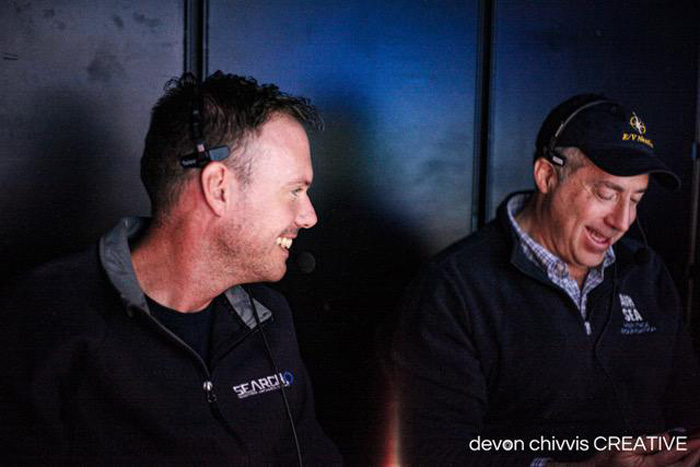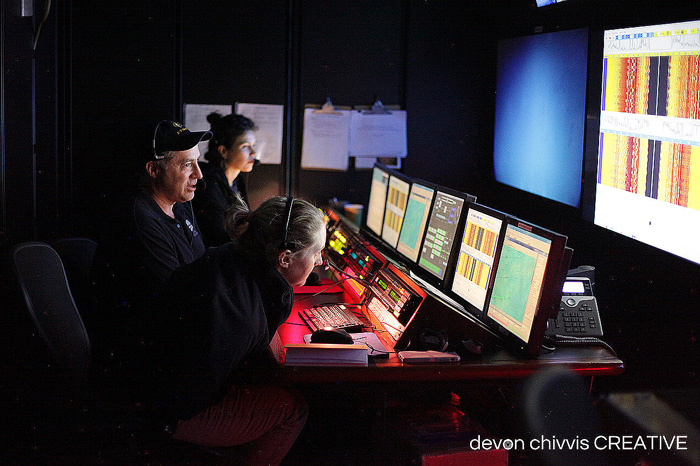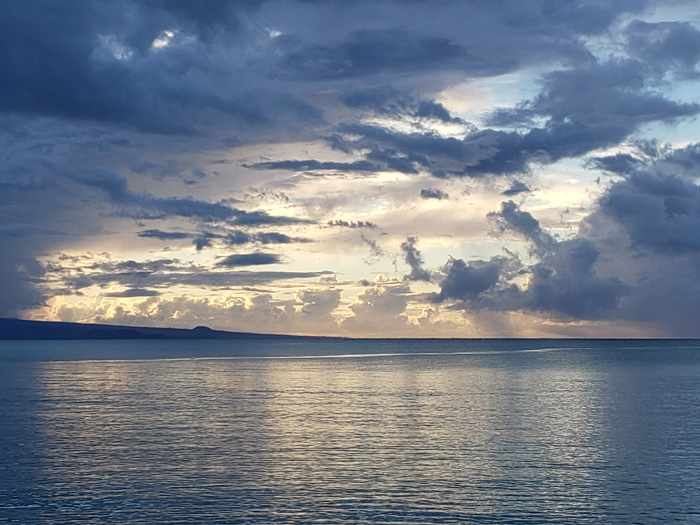THE HUNT FOR SAMOAN CLIPPPER
by Russ Matthews
https://www.airseaheritage.org/projects/
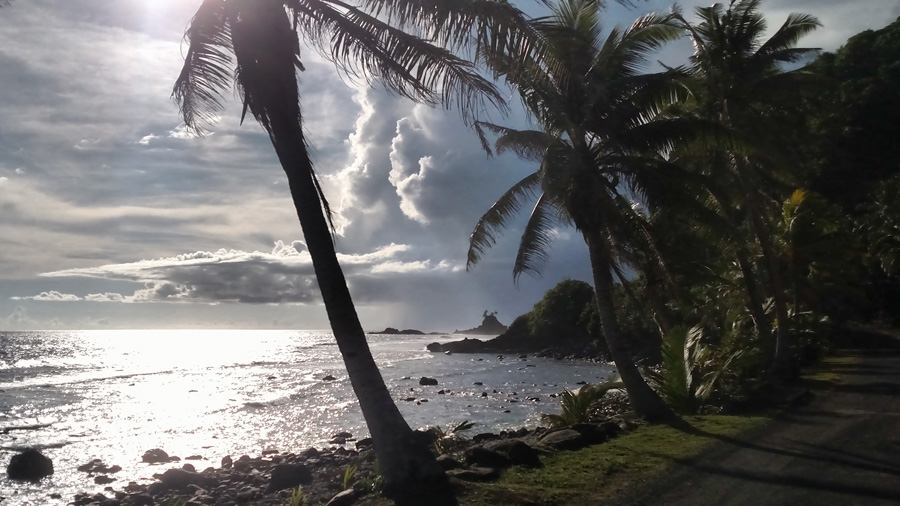
UPDATE: CURRENTLY UNDERWATER EXPEDITIONS ARE STILL ACTIVE IN THE AREA BELIEVED TO BE PRIME LOCATIONS FOR THE SEARCH FOR SAMOAN CLIPPER.
ABOARD THE E/V NAUTILUS IN 2019
July 20, 2019
For those of you who weren’t logged in, I want to share my final words on Nautiluslive from Expedition NA111 – The Search for Samoan Clipper
07/20/19
UPDATE: 0152 Hours (8 minutes bottom time remaining).
I know many of you who have been listening will have questions.
Am I disappointed? Am I frustrated?
In all honesty, yes. Who wouldn’t be? We had a very specific aim and we haven’t met it yet.
Am I upset? Am I angry?
Not in the least.
I’m proud.
Proud of the work we did. Proud of my team. Proud of this crew who made this project their own and strove tirelessly to see it through. You need look no further for proof than their record-shattering feat of 125 hours of continuous ROV operations.
I’m satisfied.
I’m satisfied we collected all of the information possible beforehand. I’m satisfied we allocated our resources responsibly. I’m satisfied we made the best decisions and prioritized areas of highest probability. I’m satisfied we made the most of our opportunities and our assets. I’m satisfied we covered our prime search grid and missed nothing.
I would not change a single decision.
I’m grateful.
Grateful for the support and fellowship of our partners at Ocean Exploration Trust. SEARCH, INC. Igor I. Sikorsky Historical Archives. University of Miami Libraries. Pan Am Historical Foundation. Pan Am Museum Foundation. And a host of incredible, passionate, giving individuals too numerous to list now.
I’m grateful to everyone listening in who joined the adventure. Who followed us. Hoped with us. Despaired with us and encouraged us.
We may not have achieved our goal, but that was not our sole aim. The only failure is failing to acknowledge and build on what we achieved.
We’ve viewed and recorded remote areas of the planet previously unseen by human eyes. We’ve mapped and characterized a large swath of unexplored territory. We’ve completed a methodical, thorough, and highly disciplined search of high priority areas and laid the groundwork for a future mission to build upon. We’ve conducted a demanding expedition with elan and integrity. And we’ve shared the entire effort with the public.
One of the things I was most excited about from the start was the chance for people to experience the full unvarnished reality of exploration. I wanted to let them inside the whole process of researching, refining, seeking, and revising. The nature of exploration is to journey into the unknown. To face uncertainty and meet it with determination and persistence.
Perhaps most importantly, we have reintroduced the world to the remarkable story of Samoan Clipper, Pan Am and the era of the great flying boats.
It all happened not far from where we are right now. We are so very close. And while we are still in this place I want to pause and remember the seven aviation pioneers who rest here.
Before we depart I will leave you with two promises.
You are not forgotten.
And we are not done with the search for Samoan Clipper.
--Russ Matthews, President, Air/Sea Heritage Foundation, Aboard E/V Nautilus off the coast of Tutuila, American Samoa, 20 July 2019.
July 19, 2019
UPDATE PART 3: 0745 Hours.
“KEEP CALM AND SIDESCAN ON”
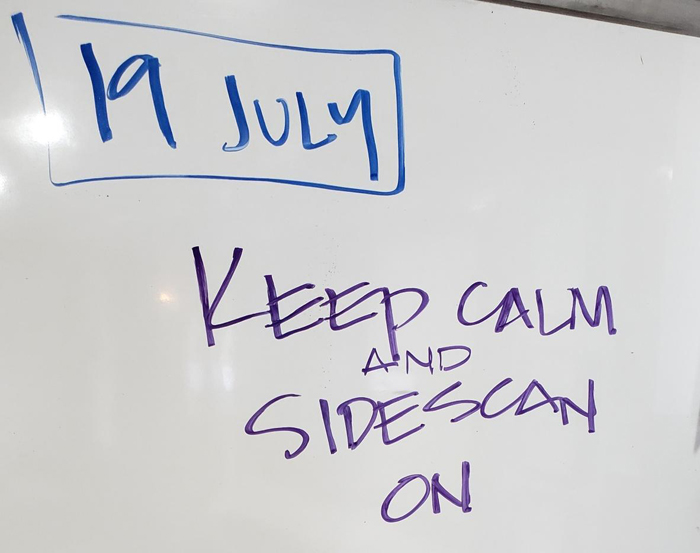
Whiteboard Update aboard E/V Nautilus
As the days allotted for our search mission tick down into hours, this message appeared on the whiteboard where daily announcements are posted for the crew. I suspect it was written by Allison Fundis, our Ocean Exploration Trust expedition leader, but it perfectly captures the spirit and determination of everyone aboard E/V Nautilus. This crew has constantly impressed me not only with their technical expertise and scientific knowledge, but by their dogged persistence mixed with good humor as they perform incredibly demanding work under the full gaze of the public at all times. Each and every one of them is vital to the safe and successful conduct of the expedition and all of them richly deserve their place aboard what our Captain rightly calls “the most famous exploration vessel in the world.” The Air/Sea Heritage Foundation team is privileged to count them as our partners, shipmates, and friends.
07/19/19 UPDATE PART 2: 1605 Hours.
I finished up my watch at midnight last night, wrote some correspondence and was about to crawl into the rack when I saw we had completed scanning the gap in Line 11 and almost reached the location of “Target 30” (since I’m staying in Dr. Ballard’s cabin there is a screen on the aft bulkhead that will display data from the sonar readout, ROV camera feed, and the ship’s track around the clock). At the same time, Mike got up and headed for the control van, so I fell in behind. There were a number of us crowded in to watch as the Argus pilot and navigator worked together to maneuver the vehicle over one of the more unusual anomalies spotted during our initial survey. This had presented as a trio of uniformly sized arrowhead shaped objects with tall and prominent shadows of something that appeared to point straight above .. reminiscent of S-42 engines nacelles with propeller blades stopped at top center (only too close together and on too large a scale to make sense). After careful study and consideration these mysterious objects proved to be .. more rocks. This was pretty much what we had figured, but needed to be certain of our interpretation by backing it up with a “ground truthing” pass. I opted to turn in for some much needed shuteye, leaving things in Meagan and Lonnie’s capable hands and with the usual standing orders to “call me when you find the plane.”
Well, no one came to wake me up, so I slept until breakfast and then settled in for the 0800-1200 shift at the monitors. Dede was already there having relieved Mike early so he could eat and she caught me up on the night’s progress. Target 31 proved to be another bit of deceptive geology and now Nautilus had returned to “mowing the lawn,” expanding the search area further into new ground on the West.
No sooner had we finished our debrief then it was time for yet another highlight. Two more special guests had agreed to join us remotely on the “Science Party Line” which is heard on the live stream broadcast from the ship. First up was our great friend and colleague, Dr. James Delgado. Jim is an extremely accomplished maritime archaeologist with an impressive list of discoveries and investigations to his credit. He should be familiar to many of you as the host of “The Sea Hunters,” a frequent contributor/consultant on Nat Geo channel’s “Drain the Ocean” and the author of many books (including the soon to be released “War at Sea”). Jim is currently the Senior Vice President of SEARCH, INC where he runs their maritime archaeology operations, working hand in hand with Mike and Dede. I credit Jim with being the spark that began the Search for Samoan Clipper when, in his former role as Director of Maritime Heritage for the NOAA Office of National Marine Sanctuaries, he invited me to join him in proposing targets for exploration in the Eastern Pacific at a workshop hosted by OET and NOAA more than 5 years ago. He demurred, pointing out as he always does, that this is a collaborative process between many outstanding individuals and institutions. For the next 30 minutes, Jim shared his insights on Samoan Clipper and underwater archaeology with genuine passion and extraordinary eloquence. If you’ve ever heard him speak, you’ll know exactly what I mean, though you might be surprised to hear me say that it is entirely extemporaneous. I swear he was not reading off a prepared script, even though it doesn’t seem possible to be that polished on the fly... it is his particular gift. We’ve missed having Jim in the field and were delighted he could at least join us virtually.
As Jim hung up, it was instantly time for the second half of our special guest “double header.” Already waiting patiently on the line was John Hill, noted historian, author of the new “Pan Am at War” (with Mark Cotta Vaz), and recently retired Assistant Director (Aviation) at the exceptional SFO Museum in San Francisco. With the easy authority born of a lifetime of study and his outgoing nature, John delivered a free flowing and engaging narrative of Pan Am’s beginnings, the role of Ed Musick, the challenge of flying the Pacific, the significance of Samoan Clipper and the impact of its tragic end. I listened in rapt attention, barely wanting to interrupt with my next question. I could have kept it going the rest of the morning (Samoan Standard Time), but knew I’d already made John 10 minutes late for his afternoon (EDT) appointments... and so (reluctantly) said goodbye with thanks.
With the sense of a job well done, I took a moment to lean back and bask in the good feeling and the gratitude in having such remarkable individuals taking part in this great adventure. Then it was back to the monitors and the mission. Time is ticking and there is scanning to be done.
07/19/19 UPDATE PART 1.
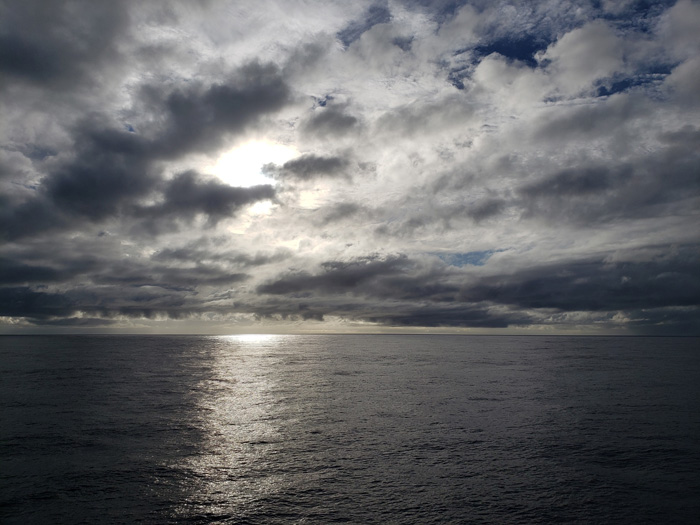
Samoan Dawn
Up at 0445 this morning, but well worth it as I got to participate in a another live interaction .. this one organized by the Pan Am Museum Foundation at the Cradle of Aviation Museum in Garden City, NY.
I’d really been looking forward to this one for some time. Linda Freire and her team have been working tirelessly for months to organize and plan a special event around this opportunity for a real time ship-to-shore exchange. The logistics issues of following the precise technical requirements involved are extremely challenging, but this one ran as smooth as silk. OET Science Communication Fellow Brian Soash ran things on my end, giving a brief and concise run down of the Nautilus program, while acclaimed author Christine Negroni moderated the proceedings at the venue, selecting participants in the Q&A, ensuring that their questions/comments were clearly understood and managing the precious satellite time available. I was able to hear the conclusion of her eloquent introduction and so was confident that I could skip my usual recitation on background and skip right to “the good part” of briefing attendees on the progress of our mission.
The questions were varied and thoughtful from an audience that covered a range of aviation professionals, Pan Am devotees, and another group of enthusiastic teenage STEM campers. I was impressed by all of them and did my best to give them equally coherent answers. One particularly memorable viewer asked if I would talk about the 6 men who were lost on board Samoan Clipper with their famous captain. It was a reminder that, too often in the interest of brevity and efficiency, we fall into talk about Ed Musick “and his crew.” Six lives reduced to three words. But they were so much more. Men with their own hopes and dreams and loved ones who mourned their loss. I was grateful for the opportunity to talk about Sellers, Brunk, Stickrod, Brooks, MacLean, and Findley… and we’re making more of a point to do so during the regular live feed as well.
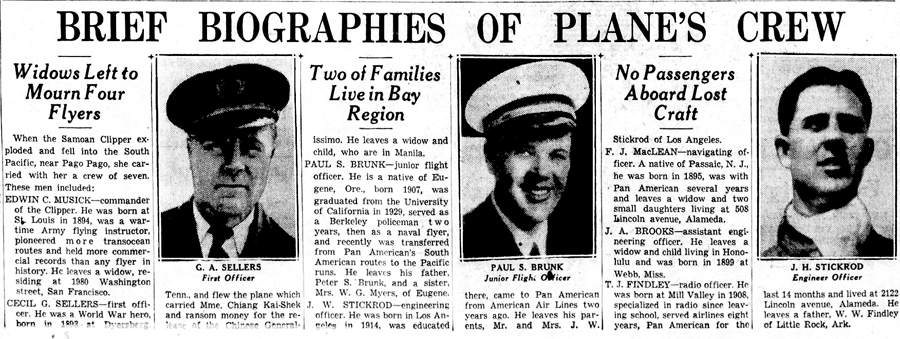
Samoan Clipper Crew Bios from San Francisco Examiner
**I found out from a Facebook post that this event was hosted in a planetarium so my mug was plastered on a screen that must be four stories tall!! Sorry for scaring all the small children and puppies**
Afterwards, Megan came to brief me on the latest search strategy she’d been discussing with Mike while he stood watch in the control van. On further review, Mike spotted a potential gap in Line 11 of our initial survey grid. We don’t want to leave anything undone in our primary search area, so that will likely call for another dedicated pass which will also put us in the vicinity of Targets 30 & 31. These are two of the anomalies that have remained “interesting” even after data processing and appear uncommon compared to the bottom features we now recognize as typical for this vicinity. We’ll run the Argus camera over these targets, enabling us to contrast the digital version interpretation of sonar pulses in the “waterfall” display with the reality of the video feed. In the meantime, however, more lines, more new ground. And the prospect of a find ever present.
I relieved Mike on the watch at 0800 for another four hour stint watching computer monitors and talking about the search, Samoan Clipper, the crew, Pan Am and aviation history. I’m perfectly happy to hold forth on any and all of these subjects and have a captive audience for my extemporaneous lectures. Our Science Communication Fellow, journalist Madison Dapcevich does a masterful job keeping the live stream commentary focused, yet fun. I sometimes think of the SCF a kind of emcee for the science operations outreach… periodically describing the project and its status (for people who may only just be joining), describing different aspects of the history and the expedition, encouraging participation and input from everyone in the control van, screening and presenting questions from viewers around the world, indulging in the occasional fits of humor or personal reflection from the crew before redirecting things back to the project at hand. I am 100% biased, but genuinely think the 8-12 watch is the best of three great teams!
Other expedition news…
>I heard a crazy cool statistic from the Argus/Herc pilots. Sometime last night we established the new OET record for continuous ROV operations. With every hour that passes, we are shattering it. I’ll wait until the end to give the exact totals since they are changing all the time.
> Data Logger Rebecca Wipfler revealed to all of us that she is a distant relative of Ed Musick!! Her special field of interest is extremophiles and hydro-thermal vents and she knew nothing of Samoan Clipper or her connection to it before the expedition began. When Rebecca explained her father about the mission and mentioned Musick’s name, he told her that there were Musicks on his side of the family. After some digging Rebecca’s parents traced the genealogy to a common ancestor about five or six generations back. Since she only discovered the connection after she got to Pago Pago, no one deliberately assigned her to this expedition because of the relation. It was just a coincidence. We prefer to think she was meant to be here and will do our best to arrange a kind of family reunion.
July 18, 2019
UPDATE: 1946 Hours. We’re approaching the end of the Northernmost line of our original survey grid. Mike showed us an interesting target with straight edges, a right angle, and some pronounced shadows that turned up during his watch (about as far to the Northeast as possible, of course). Like others before, it is interesting, but not enough to interrupt the ongoing operations. It’s been marked and the data will be processed overnight. We’ll see how it holds up in the light of day.
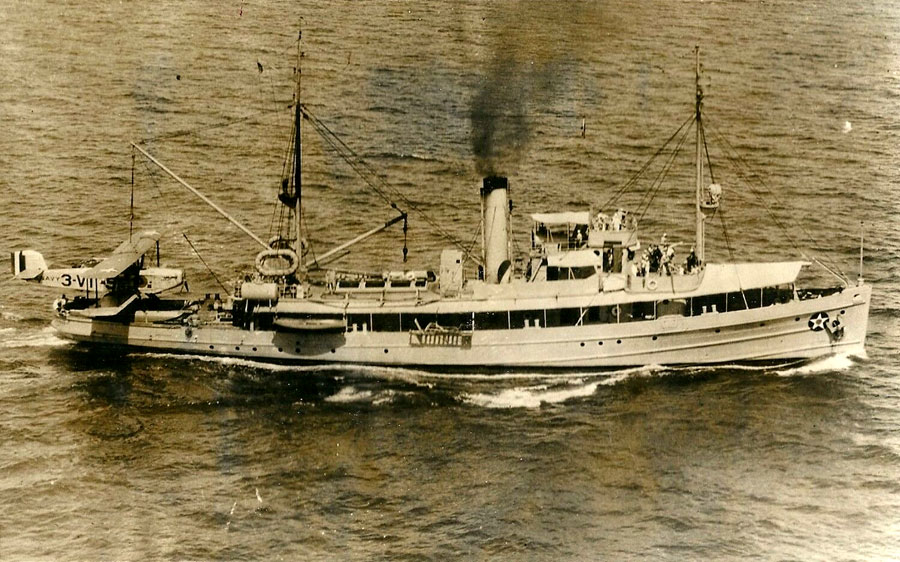
USS Avocet AVP-4 searched for Samoan Clipper after the crash, January 12, 1938
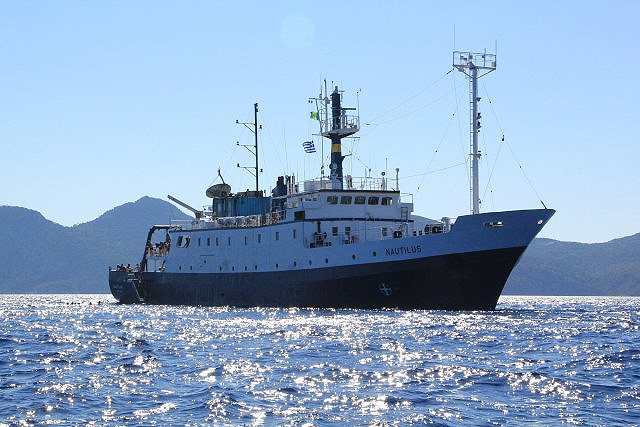
E/V Nautilus the exploration vessel now searching for Samoan Clipper July 2019
In the meantime, the plan is to start extending our search West into new ground at the end of this line. Mike and I reviewed the Bureau of Air Commerce report and noted that while the reported crash position was calculated to degrees, minutes, and seconds for latitude, the longitude value is an even 170° 51’00” W. Now it’s certainly possible the math just worked out that way, but it strikes us as maybe a little too pat. For some reason this figure is more of a rough estimate than the other. An error of only 1 degree equals one nautical mile, so we need to move beyond that to be sure.
Radiogram providing more evidence: Doors found January 22, 1938
So why to the West? The searchers were making estimates based on what they observed at the surface, but there could well have been natural forces acting on the rising traces of Samoan Clipper as they made the two mile journey up through the water column back to the sunlight. All of the evidence from the Avocet log and subsequent PAA radio traffic indicates the floating wreckage and oil was being carried to the Northeast. And the only other debris (a pair of aluminum doors from the galley ice box) known to be recovered post-crash were washed up more than a week later on the beach at Ofu in the Manu’a group which is 80 miles due East of the reported loss position. Given all of this we feel the best chance of tracking back to the point of origin is to the West. Once we’ve covered another 6-8 lines in that direction, we will likely wrap around the Southern edge of our coverage area and expand in that direction as well. There was a Northern component to the drift noted by Avocet and working back towards the island also brings us closer to the vantage point of the eyewitness. Her testimony was judged extremely reliable and anything that moves us nearer to where she was watching the events makes sense for her to be able to discern the level of detail she reported.
Other highlights of the day...
> I got to participate in my first “live interaction,” connecting via webcam and speaking with STEM students at the Pearl Harbor Aviation Museum www.pearlharboraviationmuseum.org. This amazing institution is located on Ford Island in the middle of Pearl Harbor and is the only air museum in the United States located on an actual battlefield (where bullet holes and shrapnel scars from enemy aerial attacks can still be found on the hardstand and in the hangar windows). It is also just across the bay from the site of the old Pan Am base at Pearl City, where the Samoan Clipper departed on her final journey. And there is a special exhibit dedicated to the Pan Am clippers that greets museum visitors when they first arrive. But, what really made this special was the enthusiasm and intelligence of the kids at the other end of the broadcast. I had contacted Shauna Tonkin, Director of Education & Visitor Experience at the museum before the expedition to see if they might be interested in participating in a ship to shore session while we were in the field. As it just so happened, PHAM was already planning a STEM education camp for high school students that was scheduled for July 15-19, exactly in the middle of our expedition dates. But, that’s not all. The focus of the studies was to be .. wait for it .. underwater robotic exploration! These bright kids are even building their own ROV to go exploring. I couldn’t help telling the story of how a teenaged Ed Musick, after attending the first air meet in the US (Dominguez Field, Los Angeles in 1910) was so enthralled with what he’d seen that he and his friends resolved to fly themselves. And, when faced with the enormous cost of a new flying machine, decided to build their own. It’s so gratifying that the spirit and drive to build your dreams among the youth of the world is alive and well more than a century later.
Happy Birthday Mike Brennan!
There was a signed birthday card and the galley served one of its famously decadent chocolate and Skittles cakes loaded with candles. Mike seemed pleased with the pair of science fiction books I gave him as a present, but we all know what he really wanted. We’re going to work on getting it for him before we have to leave American Samoa.
July 17, 2019
UPDATE: 0046 Hours. Yesterday started early (at 0600) with one of the highlights of the expedition so far, when our promised “special guests” joined us for a lively conversation. Pan Am Historical Foundation Chair Ed Trippe and Ocean Exploration Trust President Dr. Robert Ballard called our operations team in the field on board E/V Nautilus via satellite! They had spent the day together at OET’s “Inner Space Center” on the University of Rhode Island Narragansett campus before dialing in to the “Science Party Line.” I was able to brief them on the progress of the expedition and then give our streaming viewers the opportunity to hear Ed and Bob share their unique perspectives on the search and its significance. It was almost complete overload for me as I could have easily spent the entire morning talking to either one of them. The time seemed to fly past and practically the entire control van had a chance to contribute to the discussion. Communications Director Samantha Wishnak was so pleased she promised to put the whole exchange on Youtube for anyone who missed it live.
SEARCH, INC archaeologist Dr. Michael Brennan (l) and Air/Sea Heritage Foundation President Russ Matthews in the control van aboard E/V Nautilus for the Samoan Clipper expedition. (Photo credit: Devon Chivvis Creative)
Over the rest of the day we finished the Southern section of our initial survey grid and have set course to complete the Northern portion. Dr. Mike Brennan was able to run the data collected up until now through a special processing software and reassess most of the targets we marked for possible further investigation. Most of them appear to be naturally occurring features. I know everyone (myself included) would like them to be traces of Samoan Clipper, but this is still helpful information. We can now confidently continue with the scanning and cover new ground rather than sacrifice precious time revisiting false leads. Even so, we intend to image a select number of targets utilizing the side scan sonar from a different angle as we transit to the North.
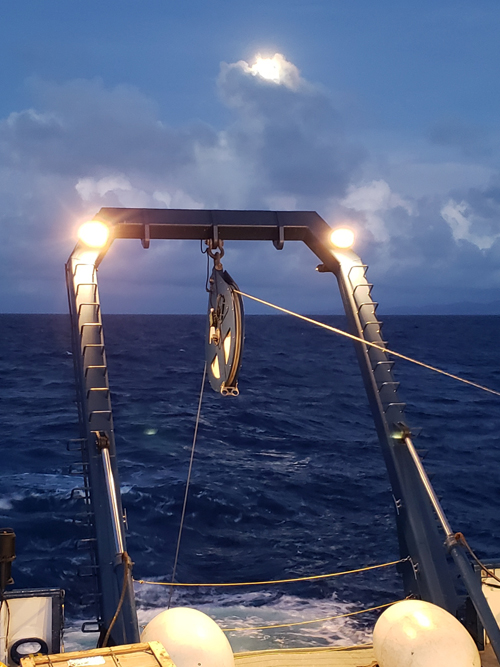
Photo shows the moon rising over E/V Nautilus’ A-frame (note the cable paid out to Argus down below).
I expect the remaining section of the original survey area will be completed by tomorrow. Barring any major discovery, we will shift our attention to another sector. Mike and I are in agreement that we should focus our effort to the Southwest. Archival information indicates that wreckage and oil from Samoan Clipper drifted generally to the Northeast… meaning we need to go in the opposite direction if we want to track it back to its origin. — Russ Matthews
July 16, 2019
UPDATE: 1950 hours. There’s a story about that Ed Musick was asked by Pan Am’s Publicity Director Wiliam Van Dusen to broadcast some “good copy” for the newspapers during the inaugural China Clipper run to Manila. The taciturn and publicity averse Musick asked what he wanted him to say and the PR man suggested “something about the sunset over the Pacific.” Several hours into the flight, Pan Am radio in San Francisco recorded a message that read: “SUNSET 6:39 HOURS”
I won’t be that brief, but the investigation has intensified and is keeping us pretty busy. Argus has been scanning the seabed for the better part of a day. Our revised East-West track lines have worked well and the wind has moderated with mostly clear skies. We passed over the crash coordinates provided in the Bureau of Air Commerce accident report and have so far marked approximately 31 targets for possible further analysis… though, nothing that appeared to be obvious aircraft wreckage. Frankly, nobody reasonably expected that Samoan Clipper would be precisely where the 1938 searchers estimated. Their work put us in the neighborhood and we now we need to do the careful work of scouring the surrounding area. I still feel it must be close by.

Interesting observations:
> Someone noted that the date of Samoan Clipper’s loss, January 11, can also be rendered as “1-11”… and that the Search for Samoan Clipper is Nautilus’s one hundred eleventh expedition, the official OET designation of which is “NA 111”
> A passing rain squall created a spectacular rainbow between the ship and the island this afternoon. I can’t help wondering what is waiting at the end of it.
It’s time for my next 4 hour watch in the control van. We’re working our way south of the reported crash location now and into some prime search area. I’ll wrap up at midnight and be back again at 0600 to hopefully speak with some special guests. -- Russ Matthews
From front to back: SEARCH, INC Archaeologist Dede Marx, Air/Sea Heritage Foundation President Russ Matthews, Ocean Exploration Trust Science Manager Suna Tuzun
July 15, 2019
UPDATE: Nautilus left the dock a little after 0800 this morning, retracing the route of USS Avocet (AVP-4) “en route to a point 12 miles north Tapu Tapu Point to search for Samoan Clipper (NC16734).” It was a thrilling moment to finally be on our way and feel a rolling deep sea swell lift the ship as soon as we made the turn to exit the inner harbor .. a good reminder of why the clipper had to use the restricted landing area despite its other hazards.
USS Avocet (AVP-4) “en route to a point 12 miles north Tapu Tapu Point to search for Samoan Clipper (NC16734).”
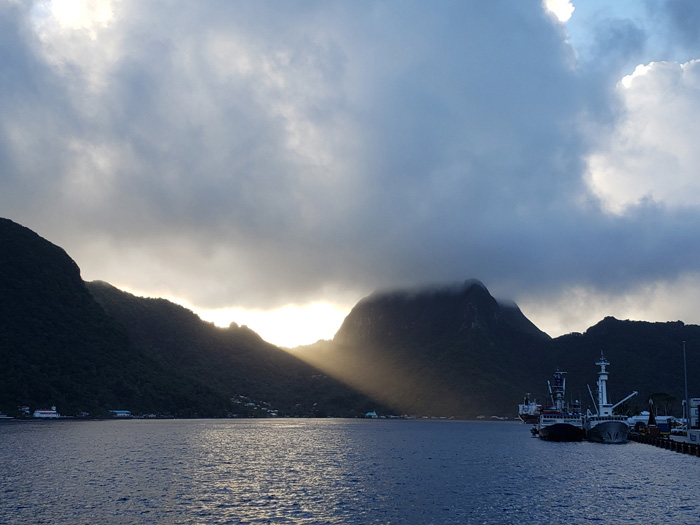
Pago Pago Sunburst
The trip around Tutuila’s west end went by quickly and we were soon rounding the headland at Tapu Tapu Point to starboard. Once in the lee of the island, Nautilus was sheltered from a Southeasterly swell and the ride smoothed out considerably. We made a dash to the North and covered the distance to the start of our first plotted search line in what seemed like the blink of an eye (especially after the long, drawn out process of getting here).
Using dynamic positioning, Nautilus held station while the Argus ROV was prepped for launch. A passing rain squall swept over the area, but the crew carried out the entire evolution with great skill despite the weather and got the vehicle in the water without incident. By 1120 Argus was diving for the seabed to hunt for signs of Samoan Clipper like a bloodhound on a very long leash.
During the deep descent, I took the watch leaders’ seat in order to answer some of the questions already flooding in from people watching on the livestream. They were varied and thoughtful and showed that there strong interest building in the mission. I did my best to answer queries and provide more background with my colleagues in the control van. Everyone had insightful comments and relevant experiences to share. I’m actually looking forward to what I can learn from all of them over the next several days.
Argus reached the seabed around 1400 hours and I surrendered my chair to Mike so that he could bring his considerable sonar expertise to bear. He’s spent a lot of time finding things on the bottom of the ocean (including from Nautilus) and it was time to let him do his thing.
We started with a 2 mile long run headed “downslope” of our search area headed roughly Northwest. This run was intended to be a “working up” period .. evaluating the performance of the sonar, getting familiar with the subsea landscape and dialing in our techniques. It was a great relief to find that the underwater slope is quite gentle... and a very pleasant surprise to discover that the downward looking Argus camera can actually see the bottom. This is big as it means our survey has no middle gap of data in the “nadir” between sonar transducers. Much of the terrain is flat and sandy, though there do appear to be a number of rocks strewn about, as can be expected from such a volcanically active area. We’re still confident that manmade metallic objects will stand out readily against this background. A stiff breeze from the east is pushing up to “crab” the ship using dynamic positioning and has cut our projected speed. The plan is now to run the next lines into/with the wind, which should increase our overall speed and reduce some of the “stretching” effect on the sonar return.
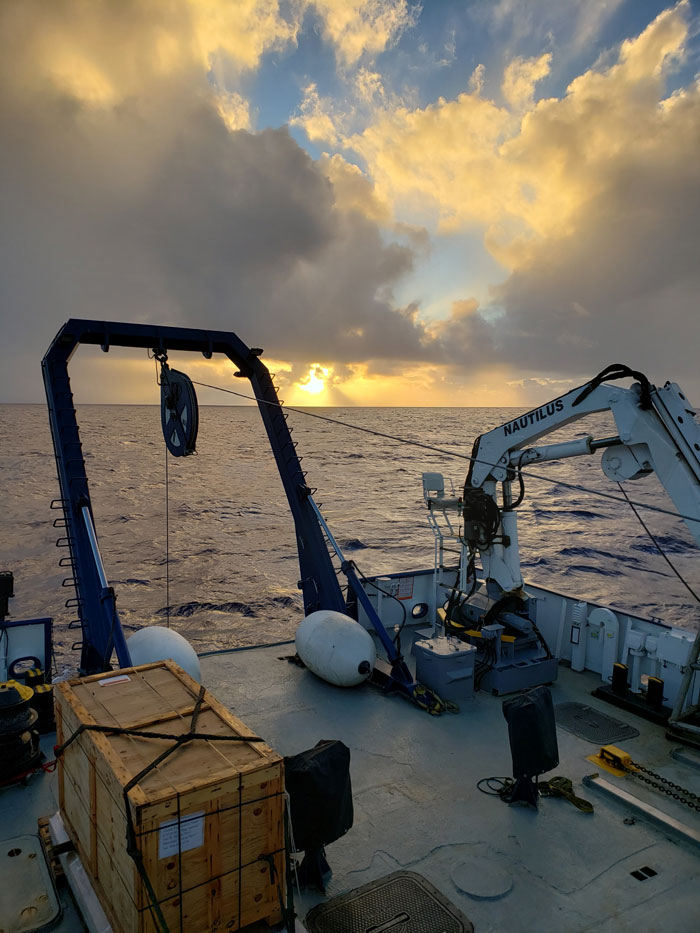
Aboard E/V Nautius July 15, 2019
This too is a part of exploration. Having the persistence to do repetitive, attention intensive work without constantly second guessing yourself helps make the prospect of discovery even sweeter. We will keep at it and hope you will all stick with us. -- Russ Matthews
July 14, 2019
07/14/19 UPDATE PART 3: On board Nautilus. The ridge behind me is where Musick would have to approach to land in the harbor. -- Russ Matthews
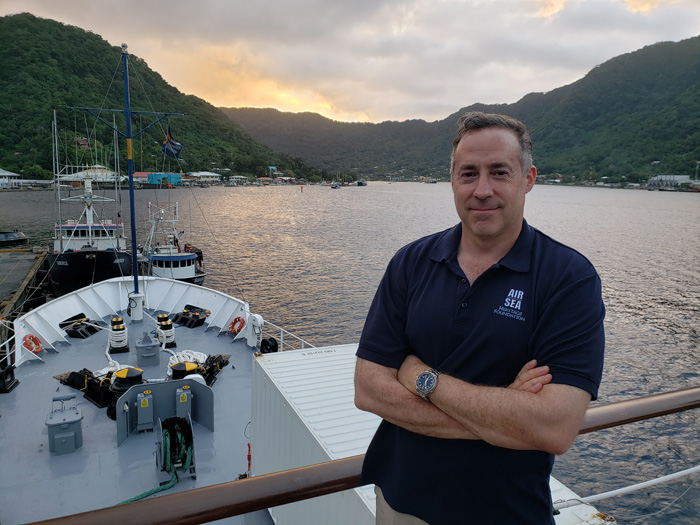
On the EV Nautilus, July 14, 2019: Russ Matthews, Samoan Clipper Expedition leader and Principal investigator @airseaheritage foundation
Samoan Clipper on Pago Pago approaching over the ridge, from Jon Krupnick Collection
07/14/19 UPDATE PART 2: Exactly as I had hoped, our flight path took us over Apia and then across to Tutuila where the unpressurized de Havilland Otter flew low along the southern coast, giving everyone on board a spectacular view of Tapu Tapu Point and the waters beyond where we will soon be searching for Samoan Clipper (I have to admit, a few of the nervous fliers in our group did not seem to fully enjoy my impromptu history lesson about following so closely in the ill-fated Musick’s wake).
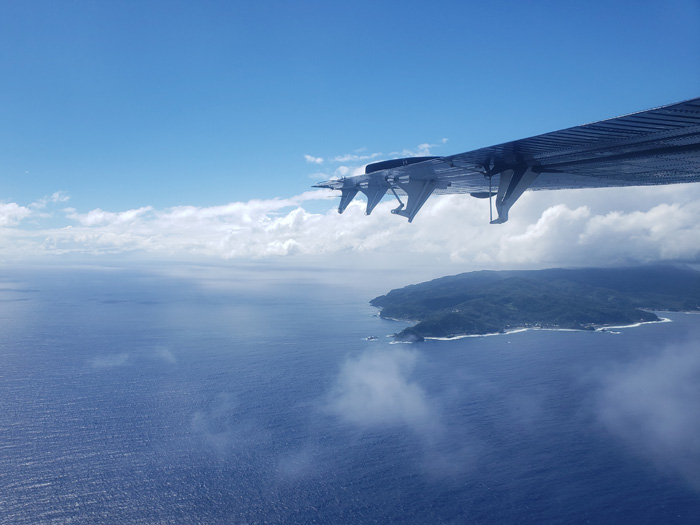
Tapu Point from the Air
Soon we were safely on the ground, having travelled back across the International Date Line and hence “back in time” (landing nearly a full day before we left). But, even as I reset my watch, it occurred to me that what we’re doing is a form of time travel. Every step brings us closer to the events of 11 January 1938 and to the place where the tangible evidence of what happened that day has remained undisturbed for more than 81 years.
A short bus ride brought us from the airport to the harbor .. and then suddenly, as if by magic, there was Nautilus. After 5 years of dreaming and effort, it hardly seems real .. but, it is. As I type, she’s tied to the pier in sight of the old Pan Am Clipper base with her bow pointed toward the ridgeline where Ed Musick made repeated hair-raising, wind whistling approaches to land in the calm, but narrow waters alongside.
Mike and I have been assigned to cabin 16. It’s a bit of a homecoming for me in that this was my berth during the 2016 mission to USS Independence. However, it is also special because this is Dr. Ballard’s cabin when he is aboard. I realize what a rare opportunity it is to be in this chair now myself, working with the incredible team he’s assembled on the ship intended to carry out his vision to explore the world’s oceans. We couldn’t ask for better partners in the search for Samoan Clipper.
The afternoon was a whirlwind of familiarization training and mission planning. Provisions are stowed, gear is prepped and the crew is eager to depart. Tomorrow morning we will get underway. -- Russ Matthews
07/14/19 UPDATE PART 1: One more flight to go. About 20 of us are gathered at tiny Fagalii Airport outside Apia, waiting to make the 35 minute island hopper jump to Pago Pago where Nautilus is docked.
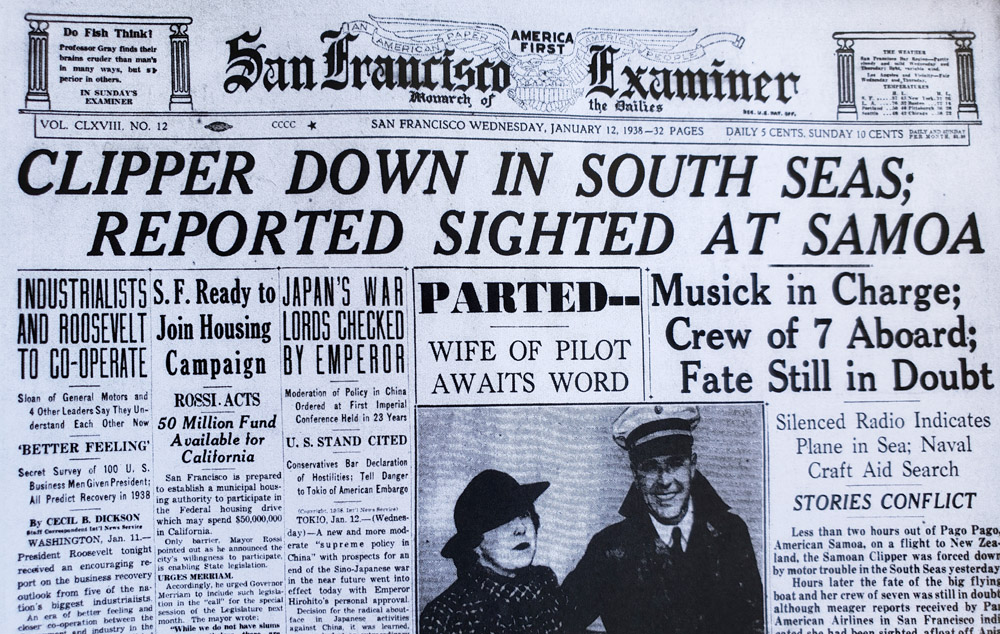
San Francisco Examiner Front Page, January 12 1938
It strikes me that we are now following even more directly in Musick's footsteps. Samoan Clipper was sighted over Apia shortly before the accident, as Captain Musick apparently scouted the harbor as an alternate landing spot while burning off some of his excess fuel. This would be the cause of some confusion and false hopes in the ensuing days as reports of the plane being seen at Samoa were hopefully interpreted to mean it had set down safely nearby.
Our flight may pass within view of Samoan Clipper's ultimate resting place as we wing our way east and draw closer to realizing our ultimate goal. -- Russ Matthews
July 13, 2019
We’ve skipped over July 12 (and the International Date Line) to arrive on the shores of Samoa. We’re here and the preparations continue. Others are arriving from all around the world and all walks of life, bringing a variety of invaluable skills and experiences to run the expedition.
Ocean Exploration Trust (OET) rotates science crews in and out through the entire field season, so people are both coming and going. I ran into Megan Cook, an old friend from my last time aboard Nautilus during the 2016 USS Independence (CVL-22) mission.She came the long way this time, visiting some well known spots (like Honolulu) and less celebrated (like Kingman Reef), though all of it instantly familiar to students of Pan Am Clipper lore.
Megan tells me that the most recent six day run was devoted entirely to mid-ocean hull mounted multibeam surveys, which left the ROV crews free to devote themselves to prepping Argus for phase 1 of our Samoan Clipper search plan. She assures me that the sonar transducers are in place and all that remains is to attach the specially designed stabilizing fin. It seems the crew is just as eager as we are to get started!
This afternoon was marked by a brief but intense series of rainsqualls that passed through, peeling water from the clouds in sheets. Fortunately, the waves and the wind strength appear relatively calm and the forecast is promising. We’re optimistic for the expedition, knowing we can run operations 24/7 in some pretty severe weather conditions.
The rains ended for the day around sunset and we were treated to a great view to the West. Of course, our destiny is hopefully waiting for us in the East. We leave to join Nautilus in Pago Pago tomorrow.
More to come. --Russ Matthews
July 11, 2019
UPDATE: The team has assembled in Los Angeles and we are waiting at the gate to depart for Samoa by way of Honolulu. It seems entirely appropriate that our journey should begin here as this is the town where a teenaged Ed Musick learned to fly more than 100 years ago!
In a career that spanned "from crate to Clipper" he helped transform Aviation from the exclusive domain of daredevils and stunt fliers into the modern air transport industry. An especially vivid example of his role in forging that path was the first flight survey flight from California to Hawaii in 1935. At the controls of a Sikorsky S-42B, appropriately dubbed Pan American Clipper, Musick tackled the longest over water route in the world, a staggering 2,400 miles of empty ocean, and made it routine.

Pan Am Pilot Ed Musick and Gooney on Midway (Photo: PAHF Collection)
At this moment, I'm just one of thousands of people taking one of what must be dozens of scheduled flights to Honolulu from this airport alone. It's incredible to think that this minor miracle now repeats itself every day. A lasting legacy of Ed Musick and the Samoan Clipper crew. -- Russ Matthews
July 5, 2019
In just TEN DAYS from now the search for Samoan Clipper will begin in earnest and I find myself looking back at the more than five years of effort that has led to this point. We’ve learned a tremendous amount in that time; a wealth of information about the circumstances that contributed to the fateful accident, details of the construction of the airplane, and clues to where it may ultimately be found. However, in pouring over all of this data, one particularly poignant realization stands out above all others; that for the people of Pan American Airways, this tragic incident was not merely business, it was family.
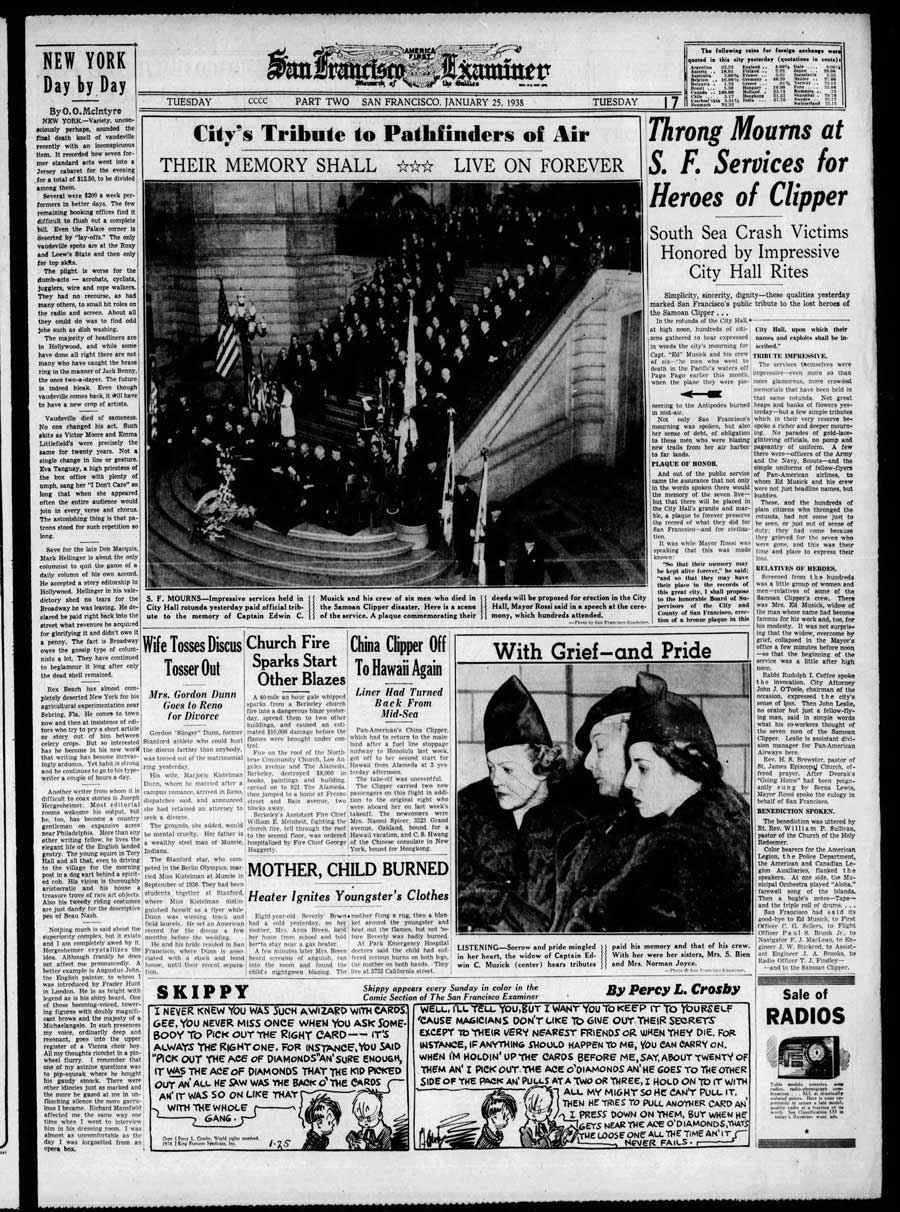
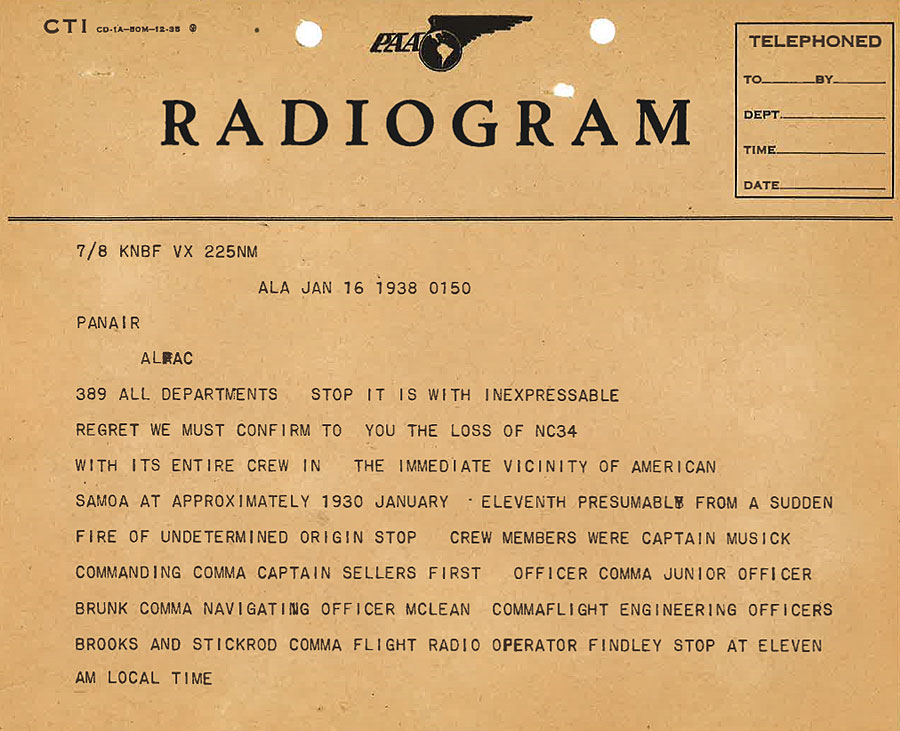
Most of them would have their worst fears substantiated on 16 January 1938 through a Radiogram (preserved at the University of Miami Special Collections Pan American World Airways, Inc. Records) addressed to “All Departments” which states, “It is with inexpressible regret we must confirm to you the loss of NC34 with its entire crew in the vicinity of American Samoa.” Just a few simple words separated from us by eighty-one years, but the sense of grief is somehow still raw and palpable. So professional were PAA’s staff that they would carefully conceal that sudden and shocking pain from their passengers.
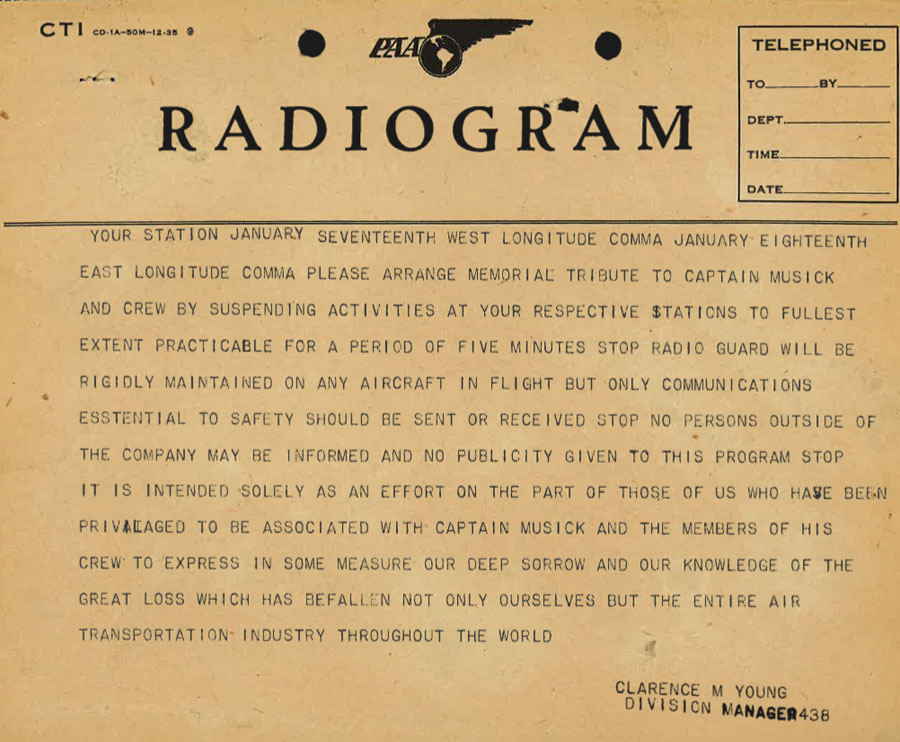
The following day (17 January 1938), Division Manager Clarence M. Young sent instructions via another Radiogram to conduct a private tribute while noting that “no person outside of the company may be informed and no publicity given to this program. Stop. It is intended solely as an effort on the part of those of us who have been privileged to be associated with Captain Musick and the members of his crew to express in some measure our deep sorrow and our knowledge of the great loss which has befallen not only ourselves but the entire air transportation industry throughout the world.”
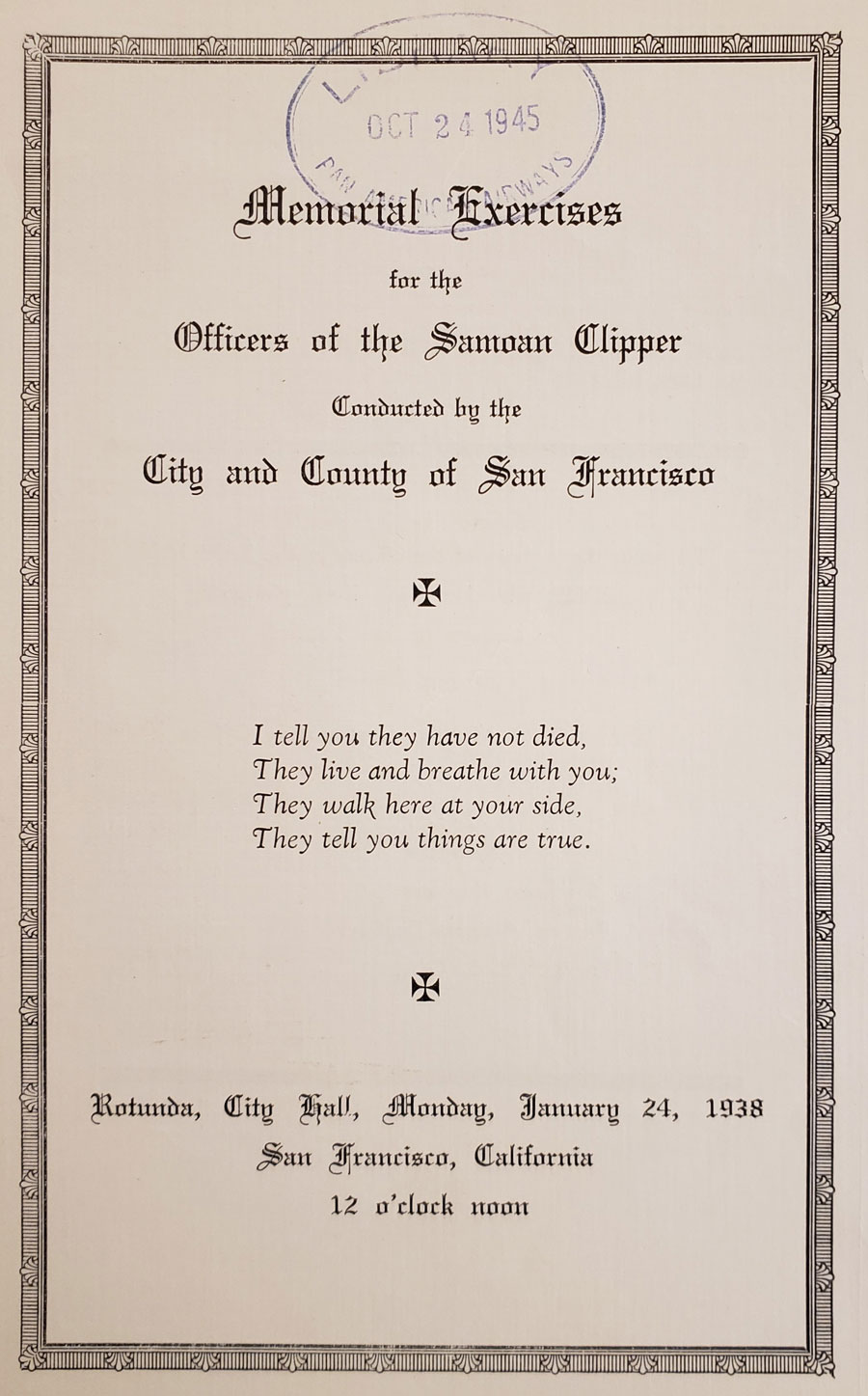
A week later, on 24 January 1938, the public was finally permitted to observe their mourning and join in paying respects to the fallen fliers at a packed memorial service on the steps of City Hall in San Francisco, Pan Am’s Pacific “company town.” Musick’s fellow pilots came dressed in suits, honoring his standing policy never to appear in uniform when not on duty.
What I find equally remarkable is the revelation that this sense of bereavement for seven “of their own” is still keenly felt among the Pan American family to this very day. The connection to those veterans, relatives, and admirers who built, sustained and preserved the PAA legacy remains undiminished by time and distance.
I, along with my Air/Sea Heritage Foundation team and our partners at Ocean Exploration Trust, are honored and humbled to be welcomed so warmly into that extended Pan Am family by people like Jon Krupnick, Linda Freire, John Hill, Ed Trippe & Doug Miller of the Pan Am Historical Foundation (and the two retired PAA pilots who turned up especially to greet us last week)... plus so many others who have generously given of their time and efforts as well as the numerous Facebook posters offering kind words of support and encouragement for the project across the wide variety of organizations that have shared our story.
I’ll be working closely with THE PAN AM HISTORICAL FOUNDATION IN THE COMING DAYS to bring you regular updates on our progress as the expedition approaches and gets underway. I hope these posts will be shared amongst a wide range of social media feeds and that readers will likewise continue to contribute their thoughts, memories, and insights on Musick, Samoan Clipper, and the great Pan American flying boat era as we go forward.
Together we will write the next chapter of this story, give it to the world, and hopefully bring a sense of closure for all of the family members, near and far.
Updates by Russ Matthews published by Pan Am Historical Foundation in 2019.
Link to Related Articles




